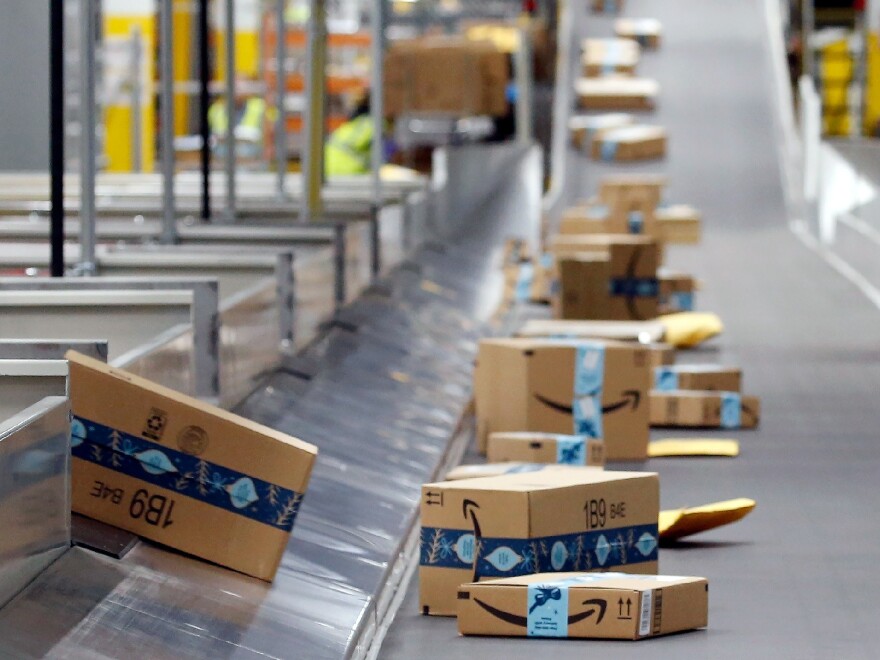Updated February 2, 2023 at 6:16 PM ET
After a long run of surging profits from pandemic-era shopping sprees, Amazon is feeling the hangover. The retail and tech giant is reporting its first unprofitable year since 2014.
Amazon lost $2.7 billion last year, the company said on Thursday. This was despite holiday-season sales growing 9%. Amazon's shares fell in after hours trading.
By far, the biggest culprit for Amazon's losses over the year was the company's hefty investment in the electric automaker Rivian whose value plummeted last year and ate into Amazon's bottom line.
Amazon had taken a 20% stake in Rivian and has begun rolling out the carmaker's electric delivery vans. Rivian wanted to replicate Tesla's success and held one of the largest initial public offerings in U.S. history. But last year, the exuberance faded, the carmaker made pricing missteps and it fell short of growth targets. Its stock price dropped 82%.
For Amazon, the loss on its investment comes right when it contends with the need to recalibrate after a pandemic-era upsurge.
During the pandemic, the appetite for online shopping seemed to promise exponential growth, and many believed the habit changes could be permanent. Amazon couldn't hire and built warehouses fast enough; its profits doubled and kept growing. But then people returned to physical stores, switched from cocooning to travel and outings, and eventually got more hesitant to spend as inflation rose.
Amazon began reconsidering its warehouse expansion plans. Industry reports tracked cancellations, closures and delays. Andy Jassy, in a rare Amazon CEO appearance on a quarterly call with investors, said his top priority was cutting costs in the company's operations.
"It's important to remember that over the last few years we took a fulfillment-center footprint that we built over 25 years and doubled it in just a couple of years," he said. "We at the same time built out a transportation network, for last mile, roughly the size of UPS. ... Just to get those functional, it took everything we had."
Last month, Amazon announced it expected to cut 18,000 jobs, or about 5% of the corporate workforce. Jassy, in a blog post, referenced "the uncertain economy" and the company's pandemic-era hiring spree.
At the peak, in late 2021-early 2022, Amazon employed more than 1.6 million part-time and full-time workers globally. Thursday's financial report shows that number is now down to 1.5 million.
In October, the company — the second-largest private employer in the U.S. — raised the average starting pay for U.S. warehouse and delivery workers to $19 an hour from $18 to stay competitive.
Now, Amazon is also seeing growth slow down also in its biggest money-maker, the cloud computing business — as companies scale back in the face of high inflation and interest rates.
When reporters asked about the slowdown at Amazon Web Services Thursday, Chief Financial Officer Brian Olsavsky said: "We realize everyone's trying to cut their budgets – we are in our main Amazon business... We do expect to see some slower growth rates for the next few quarters."
Still, Amazon continues to invest in new ventures. The company is working to close its $4 billion deal to buy One Medical, a chain of primary-care clinics. And it launched a $5 subscription service for generic prescription medication for its paying Prime members, hoping to draw more people into the program.
Separately, the company faces a protracted fight against an upstart unionization push. Amazon last month lost its bid to overturn the first-ever union win at a Staten Island warehouse. Federal labor officials ordered the company to begin bargaining with the Amazon Labor Union. But the matter is likely to reach courts.
In recent weeks, Amazon received a series of citations for safety violations from federal inspectors at the Occupational Safety and Health Administration. This is for six warehouses in Colorado, Florida, Idaho, Illinois and New York.
OSHA officials found Amazon warehouse workers at high risk of lower back and other injuries from twisting, bending and lifting that they perform as much as nine times per minute. The company was expected to appeal, and a spokesperson said the allegations didn't "reflect the reality of safety at our sites."
Editor's note: Amazon is among NPR recent financial supporters and pays to distribute some of our content.
Copyright 2023 NPR. To see more, visit https://www.npr.org.




